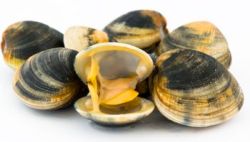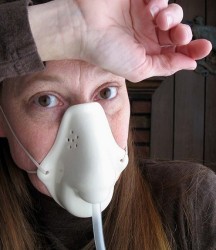I am putting fish and seafood in the spotlight again, and this time bivalve molluscs in particular, sorry about that. To be honest I have nothing against fish and seafood, but you can find a lot of nasty things in this food category – including marine biotoxins. It is of course at least partly balanced by the good nutrients also present as long as you don’t get sick. In this case the hazard source is already in the name – marine biotoxins – implying that there are a range of bioactive poisons present in the marine environment and we can blame algae for that.
First the basics. In the marine environment, single-celled, microscopic, plant-like organisms live in the well-lit surface layer. These organisms are called phytoplankton or micro-algae and form the base of the food chain that feed nearly all other marine life. So far so good, but of the more than 5000 species of marine phytoplankton that exist worldwide, close to 2% are known to be able to produce harmful toxins. And blooms of such algae can be disastrous.
Potent poisons accumulate during algal bloom
An algal bloom is a rapid increase in the number of certain algae in the aquatic system often resulting in a distinct colour change of the water surface. Typically, only one or a small number of phytoplankton species are involved. Algae can be considered to be blooming at concentrations of hundreds to thousands of cells per millilitre, but may reach millions of cells per millilitre. About 75 of the micro-algal species have the capacity to produce a range of potent poisons called phycotoxins.
Bivalve molluscs, such as mussels, clams, oysters and scallops, are filter feeders and, therefore, accumulate toxins produced by the microscopic algae. These toxins can find their way through the food chain from algae and molluscs to humans at the top of the chain causing a variety of gastrointestinal and neurological illnesses. Some algal species already produce enough toxins at fairly low numbers difficult to detect in the water, while other algal species must occur at high visual levels to be harmful. Most of the harmful species can be found only in limited geographical areas but some harmful species have a worldwide distribution.
Intriguing symptoms from shellfish poisoning
And now to the most intriguing part covering the varied symptoms when poisoned depending on the specific toxin involved. There are four separate syndromes associated with marine biotoxins and shellfish poisoning. They can respectively lead to paralysis, that is loss of muscle function, amnesia, that is memory loss, other neurological symptoms or simply diarrhea.
First we have Paralytic Shellfish Poisoning or PSP. The principal toxin responsible for PSP is saxitoxin. The disease was described about 200 years ago during explorations of the Canadian shore line when four crew members got sick after consuming mussels for breakfast and at least one died. However, the structure of saxitoxin was only determined some 30 years ago. The toxin is heat stable, like the other phycotoxins, so ordinary cooking methods do not eliminate it. Some shellfish can store this toxin for several weeks after a harmful algal bloom passes, and others, such as butter clams, are known to store the toxin for up to two years.
Until 1970, PSP-producing phytoplankton were only known from temperate waters of Europe, North America and Japan. Twenty years later they had also been found throughout the Southern Hemisphere from South Africa and India to Australia and the Philippines. Guatemala was affected by a PSP outbreak in July and August of 1987 involving 187 people showing characteristic neurologic symptoms of which 26 died. In April 2012, three cases of PSP were reported in the colder water around the Juneau area of Alaska. In December, 2012, a large outbreak of PSP affecting about 30 people occurred involving shellfish harvested from the Bay of Plenty in New Zealand.
Early symptoms of PSP include tingling of the lips and tongue, which may begin within minutes of eating toxic shellfish or may take an hour or two to develop. Symptoms may progress to tingling of fingers and toes and then, as the name implies, the loss of muscle control in the arms and legs. This can be followed by difficulty in breathing leading to shortness of breath or a choking feeling. Some people have experienced a sense of floating or nausea. Muscles of the chest and abdomen may become paralysed. PSP can be fatal in extreme cases, particularly in immunocompromised individuals. With high toxin exposures, death can occur in as little as 2 hours from paralysis of the breathing muscles. Children seem to be more susceptible than adults.
Second we have Amnesic Shellfish Poisoning or ASP. The principle toxin responsible for ASP is domoic acid. Domoic acid acts as a neurotoxin, causing permanent short-term memory loss, brain damage, and death in severe cases. ASP was first discovered in humans late in 1987, when a serious outbreak of food poisoning occurred in eastern Canada. Three elderly patients died and other victims suffered long-term neurological problems. Because the victims suffered from memory loss, the term “amnesic” shellfish poisoning was coined for the disease. However, there are also other initial symptoms that can appear 24 hours after ingestion of affected molluscs. They may include vomiting, nausea, diarrhea, abdominal cramps and haemorrhagic gastritis. More severe neurological symptoms can take up to three days to develop. These include headache, dizziness, disorientation, vision disturbances, loss of short-term memory, motor weakness, seizures, profuse respiratory secretions, hiccoughs, unstable blood pressure, cardiac arrhythmia and coma. Death has occurred at very high doses particularly in older people with renal failure.
The third disease is Diarrhetic Shellfish Poisoning or DSP caused by okadaic acid and affecting mainly Europe and Japan. In January 2000, 120 people went to emergency departments in Greek hospitals complaining of acute gastrointestinal illness after having eaten mussels. Analysis of mussels harvested in the Thermaikos Gulf in Thesaloniki showed DSP toxins. In June 2009, 11 DSP outbreaks were reported in France within a few days involving 45 individuals who had consumed mussels.
As the name suggests, this syndrome manifests itself as diarrhea, although nausea, vomiting and cramps are all common, too. DSP and its symptoms usually set in within about half an hour of consuming the shellfish, and last for about one day. Okadaic acid inhibits intestinal cellular de-phosphorylation that causes cells to become very permeable to water resulting in profuse diarrhea with a risk of dehydration. However, no fatalities from DSP have ever been recorded.
Finally we have Neurotoxic Shellfish Poisoning or NSP caused by the consumption of shellfish contaminated by brevetoxins. It was initially thought to be endemic only to the Gulf of Mexico with reports of red tides as early as 1844, but in early 1993 an outbreak involving 180 individuals was reported from New Zealand. The brevetoxins are toxic to fish, marine mammals, birds and humans, but not to shellfish. Symptoms in humans occur within 30 minutes to three hours and include nausea, vomiting and diarrhea and a variety of neurological symptoms such as arrhythmias, numbness, tingling, paresthesias of lips, face and extremities, slurred speech, cramps, bronchoconstriction, paralysis, seizures and coma. No fatalities have been reported but there are a number of cases which led to hospitalisation.
Among the most potent toxins
It is worth re-iterating that marine biotoxins produced by phytoplankton are some of the most potent toxins in the world and extremely dangerous. For some toxins, doses at the microgram per kilogram level are more than sufficient to kill. When enough toxin is accumulated in fish or shellfish, small amounts of cooked or raw tissue can kill a human. Other less potent toxins may accumulate to such high levels that they still can cause harm.
The list of phycotoxins are expanding and new diseases discovered. Azaspiracid poisoning is one of the more recently discovered seafood poisonings and probably more dangerous than previously known classes of shellfish toxins. It was identified following cases of severe gastrointestinal illness from the consumption of contaminated mussels from Ireland, and now contamination has been confirmed throughout the western coastline of Europe. Ciguatera fish poisoning is mainly found in Pacific, Caribbean and Indian Ocean region but were recently identified for the first time in fish caught in Europe. It causes a complex syndrome characterised by a wide variety of symptoms such as gastrointestinal, neurological and cardiovascular effects. And there are more.
The risk of poisoning from consumption of shellfish is serious and of concern to public health authorities in all coastal environments. The risk and threat to public health is so great that virtually all countries have instituted some form of risk management plan to deal with marine biotoxins. Regular testing of shellfish batches using a mouse bioassay are commonly prescribed. However, such tests are very unspecific and not sensitive enough for some of the phycotoxins. In a range of opinions published between 2008 and 2009, the European Food Safety Authority recommended a move from the mouse test to specific chemical methods.
Possible actions
What can you do? You could of course trust that the official testing will pick up all cases of toxins over the critical limit for illness. The outbreaks reported worldwide on a regular basis indicate that current testing is far from perfect. Or you could stop eating shellfish. Or you could just rely on your short-term memory loss and forget that you ever got sick from eating shellfish.
Related articles
- Alaska Issues Red Tide & PSP Alert For Shellfish (todayinfoodsafety.com)
- Transformation of paralytic shellfish poisoning toxins in UK surf clams (Spisula solida) for targeted production of reference materials (scicombinator.com)
- Better give up fish for Lent (bio230fall2010.wordpress.com)
- Algal bloom revisits east coast fisheries (abc.net.au)
- Poisoning threat puts shellfish off limits (nzherald.co.nz)
- Tasmanian seafood industry says algal bloom testing needs an upgrade (abc.net.au)




